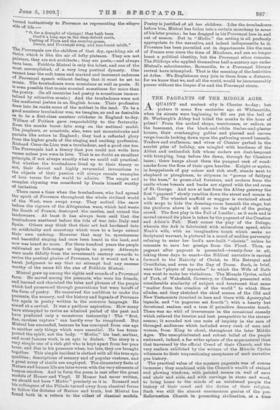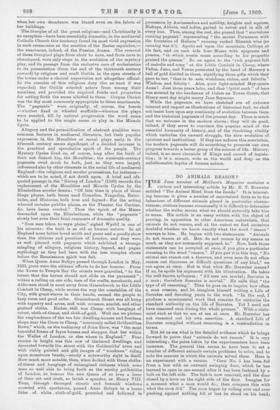THE PAGEANTS OF THE MIDDLE AGES.
AQUAINT and ancient city is Chester to-day; but picture it some five centuries ago at Whitsuntide, when its streets were beginning to fill are yet the bell of St. Werburgh's Abbey had tolled the monks to the hour of prime! From the arched shops, warehouses, or cellars, at the basement, rise the black-and-white timber-and-plaster houses, their overhanging gables and pierced and carven verge-boards looking down upon the gathering crowd beneath. Traders and craftsmen, tend wives of Chester garbed in the
scarlet gites of holiday, are mingled with bondmen of the Abbot and outlandish folk whose cockers are dust-besprent with tramping, long before the dawn, through far Cheshire lanes ; there hangs about them the pungent reek of wood- smoke from the fires of their open hearths. Knight or squire, in houppelancle of gay colour and rich stuff, stands next to shepherd or ploughman, to shipmen in " gowne of faldyng to the knee," to green-clad foresters, and archers from the castle whose breasts and backs are signed with the red cross of St. George. And now at last from the Abbey gateway the first " pageant " slowly rumbles down the street and comes to a halt. The wheeled scaffold or waggon is curtained about with serge to hide the dressing-room beneath the stage, but the platform above is all open to the sight of the gazing crowd. The first play is the Fall of Lucifer ; as it ends and is moved onward its place is taken by the pageant of the Creation and Adam's Fall. Next comes the play of the Deluge, wherein the Ark is fabricated with miraculous speed, while Noah's wife, with an imaginative touch which seeks no Scriptural warrant, is pictured in a mood of sudden perversity refusing to enter her lord's new-built " cheiste" unless he consents to save her gossips from the Flood. Thus, as pageant after pageant is presented—twenty-four in all, taking three days to enact—the Biblical narrative is carried forward to the Nativity of Christ, to His Betrayal and Crucifixion, and even to the Day of Doom. Such, in brief, were the " pleyes of rayraeles" to which the Wife of Bath was wont to make her visitations. The Miracle Cycles, called of York, of Wakefield, Coventry, or Chester, presented with considerable similarity of subject and treatment that same "matter from the creation of the world" to which Stow alludes, and they sketched the chief scenes of the Old and New Testaments (touched in here and there with Apocryphal legends, and "in pageutea set fourth ") with a hearty but devotional realism and a true if primitive dramatic touch.
There was no whit of irreverence in the occasional comedy which relieved the tension and lent perspective to the sterner scenes ; it sounded not one note of impiety in the ears of thronged audiences which included every rank of men and women, from King to churl, throughout the later Middle Ages. The unsophisticated and robust belief of the people embraced, indeed, a far wider sphere of the supernatural than that traversed by the official ()reed of their Church, and the very realism exhibited by the writers of the Miracle Cycles witnesses to their unquestioning acceptance of each narrative qua history. The practical value of the mystery pageants was of course immense ; they combined with the Church's wealth of stained and glowing windows, with painted scenes on wall of nave and choir and aisle, and with carvings in stone and wood, to bring home to the minds of an unlettered people time history of their creed and the deties of their Such was still the almost unconscious genius of the pre- Reformation Church in promoting civilisation, at a time when her own decadence was blazed even on the fabrics of her buildings.
The liturgies of all the great religions—and Christianity is no exception—have been essentially dramatic; in the mediaeval Catholic Church this tendency found its most vivid expression in such ceremonies as the erection of the Easter sepulchre,— the enactment, indeed, of the Passion drama. The removal of these liturgical plays from choir to nave, and from nave to churchyard, were only steps in the evolution of the mystery play, and its passage from the exclusive care of ecclesiastics to its presentation (from the end of the thirteenth century onward) by religious and craft Guilds in the open streets of the towns under a clerical supervision not altogether official.
In the exercise. of this religions duty (for as such it was
• regarded) the Guilds selected actors from among their members, and provided the required funds and properties for setting forth the scene allotted to them. Corpus Christi was the day most commonly appropriate to these enactments. The "pageants" were originally, of course, the boards —whether fixed or, wheeled scaffolds—whereon the plays were enacted, till by natural progression the word came to be applied to the single scene or play in the Miracle Cycle.
Allegory and the personification of abstract qualities were common features in mediaeval literature, but their popular expression in the Moralities or moral plays early in the fifteenth century seems significant of a decided increase in the practical and speculative spirit of the people. The Mystery Cycles lived op, of course, long after the birth of their not distant kin, the Moralities ; the sixteenth-century pageants owed much to both, just as they were largely influenced also by other elements in the social life of mediaeval England—the religious and secular processions, for instance— which are to be noted, if not dwelt upon. A brief and of t- quoted passage in the " Survey of London" (1598) records the replacement of the Moralities and Miracle Cycles by the Elizabethan secular drama: "Of late time in place of those Stage playes, bath beene used Comedies, Tragedies, Enter- ludes, and Histories, both true and fayned : For the acting whereof certain° publike places, as the Theater, the Curtine, &c. have beene erected." Thus the spirit of the Muses descended upon the Elizabethans, while the " pageants " slowly lost even their faint remnants of dramatic quality.
"Sum men loken to veyn plaies," sighed Wyclif in one of his sermons: the trait is as old as human nature. In all England none bettor loved mirth and game and a goodly show than the citizens and prentices of London, and they were as well pleased with pageants which exhibited a strange mingling of allegory, religious history, legend, and pagan mythology as they had been with the less complex shows before the Renaissance spirit was felt.
When Queen Anne Boleyn passed through London in May, 1533, groat were the citizens' efforts to do her honour. From the Tower to Temple Bar the streets were gravelled, "to the intent that the horses should not slide on the pavement " ; within a railing on one side, men of the crafts, merchants, and Aldermen stood in meet array from Gracechurch to the Little Conduit in Cheap, while across the way the constables of the City, with great staves in their hands, caused the people to keep room and good order. Gracechurch Street was all bung with tapestry and arras, and with crimson, scarlet, and other grained cloths. Richer still was Cheap with hangings of velvet, cloth-of-tissue, and cloth-of-gold, Well can we picture the resplendence of the ten fair dwelling-houses and fourteen shops near the Cross in Cheap, "commonly called Goldsmithes Rowe," which, on the testimony of John Stow, was "the most beautiful frame of fayre houses and shoppes, that bee within the Wanes of London, or else where in England." Four stories in height was this row of timbered dwellings, and decorated towards the street with the Goldsmiths' arms and with richly painted and gilt images of "woodmen" riding upon monstrous beasts,—surely a noteworthy sight in itself.
How much more notable, then, when decked with those cloths- of-tissue and hangings of unimagined richness which none were so well able to bring forth as the worthy goldsmiths of London, to honour the new Queen of so true a lover of their art and craft, so lavish a spender, as Henry VIII. Thus, through thronged streets and beneath windows crowded with spectators, passed Anne Boleyn in a horse litter of while cloth-of-gold, preceded and followed in procession by Ambassadors and nobility, knights and squires, Bishops, Abbots, and ladies, garbed in velvet and in silk of every hue. Thus, among the rest, she passed that "marvelous cunning pageant" representing "the mount Parnassus with the founteine of Helitton " running racked Rhenish wine (so cunning was it !) Apollo sat upon the mountain, Calliope at his feet, and on each side four Muses with epigrams and poesies, "in which everie muse according to hr propertie praised the queene." So on again to the "rich pageant full of melodie and song" at the Little Conduit in Cheap, where Pallas, Juno, and Venus presented by the hand of Mercury a ball of gold divided in three, signifying three gifts which they gave to her, "that is to saie, wisedome, riches, and felicitie." Wisdom and felicity! Alas, poor light-minded May-queen Anne! Just three years later, and that " lyttel neck" of hers was severed by the headsman of Calais on Tower Green, that Henry next day might marry Jane Seymour.
While the pageants we have sketched are of extreme interest and import as illustrations of historical fact, we shall not insist here upon any continuity of evolution between tlietni and the historical pageants of the present day. There is much that we welcome in the modern shows ; they will do good, indeed, if they serve to convince the popular mind of the essential humanity of history, and of the throbbing vitality which underlies the onward struggle, the slow evolution of opinions and institutions. If they can enforce this conviction, the modern pageants will do something to promote our own progress towards a better grasp of the science of life. History, indeed, is no mere chronicle of Kings and record of legisla- tion; it is a science, wide as the world and deep as the unfathomable depths of human nature.











































 Previous page
Previous page